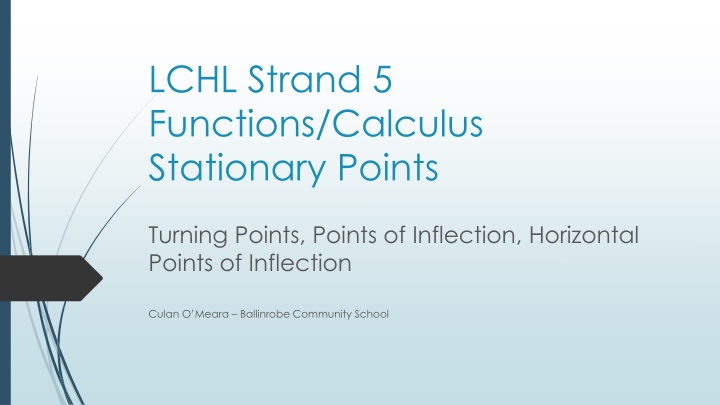
Stationary Points, Turning Points, and Inflection Points in Calculus
Explore the concepts of stationary points, turning points, and inflection points in calculus with detailed explanations and illustrations. Learn about local maximum and minimum points, points of inflection, and horizontal points of inflection, as well as the role of slope in determining these points. Author Culan O'Meara provides insights and examples to enhance your comprehension of these critical mathematical concepts.
Download Presentation

Please find below an Image/Link to download the presentation.
The content on the website is provided AS IS for your information and personal use only. It may not be sold, licensed, or shared on other websites without obtaining consent from the author. If you encounter any issues during the download, it is possible that the publisher has removed the file from their server.
You are allowed to download the files provided on this website for personal or commercial use, subject to the condition that they are used lawfully. All files are the property of their respective owners.
The content on the website is provided AS IS for your information and personal use only. It may not be sold, licensed, or shared on other websites without obtaining consent from the author.
E N D
Presentation Transcript
LCHL Strand 5 Functions/Calculus Stationary Points Turning Points, Points of Inflection, Horizontal Points of Inflection Culan O Meara Ballinrobe Community School
Stationary Points Three types: Turning points Inflection Points Horizontal Inflection Points Author: Culan O'Meara
Turning Points Can either be local maximum or minimum points of function f(x) At both points, slope of f = 0 [f (x) = 0] Author: Culan O'Meara
Turning Points Local Maximum = Point where slope goes from positive to negative Author: Culan O'Meara
Turning Points Local Maximum = Point where slope goes from positive to negative Author: Culan O'Meara
Turning Points Local Minimum = Point where slope goes from negative to positive Author: Culan O'Meara
Turning Points Local Minimum = Point where slope goes from negative to positive Author: Culan O'Meara
Turning Points Local Minimum = Point where slope goes from negative to positive Author: Culan O'Meara
Turning Points On this graph there are no turning points but it does have an inflection point Author: Culan O'Meara
Inflection Points Point where slope of curve goes from increasing in steepness to decreasing (or vice versa) Author: Culan O'Meara
Inflection Points Point where Slope of f (x) =0 [f (x)=0] Author: Culan O'Meara
Horizontal Inflection Points Special case where the point is both a stationary point and an inflection point Two conditions must be met: f (x)=0 f (x)=0 Author: Culan O'Meara
Horizontal Inflection Points There are none on the graph we have been using as at no point is f (x) = f (x)=0 Author: Culan O'Meara
Horizontal Inflection Points On this graph, both f (x) and f (x) = 0 at x = 0 Author: Culan O'Meara
Turning Points From earlier, this graph, this point can t be a horizontal inflection point because it doesn t meet the two conditions outlined Author: Culan O'Meara
